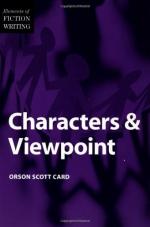
|
| Name: _________________________ | Period: ___________________ |
This test consists of 15 multiple choice questions and 5 short answer questions.
Multiple Choice Questions
1. What is a viewpoint narrator?
(a) One that observes and comments on the narrative from the perspective of the reader.
(b) One that observes and comments on the narrative from the perspective of a single character.
(c) One that observes and comments on the narrative from the perspective of only the minor characters.
(d) One that observes and comments on the narrative from the perspective of only the major characters.
2. What exists to provide justification for unexplained changes?
(a) History.
(b) Omens.
(c) Flashbacks.
(d) Fiction.
3. When is telling a story valuable to a narrative?
(a) Only when it explains a past action.
(b) Only when it advances future action.
(c) Only when it explains a present or future action.
(d) Only when it advances present action.
4. What is the amount of justification proportionate to?
(a) The number of events involved in the character being justified.
(b) The event being justified.
(c) The character being justified.
(d) The number of characters involved in the event being justified.
5. How much fiction uses random transformation?
(a) None.
(b) Some.
(c) Most.
(d) All.
6. Based on the author's quote at the end of Chapter 16, when is a first person narrative not worth doing?
(a) When it reveals the opinions of the narrator.
(b) When it does not reveal the opinions of the narrator.
(c) When it reveals the narrator's character.
(d) When it does not reveal the narrator's character.
7. Why do some readers interpret a change in a character that was not written to change?
(a) The reader did not understand the plot.
(b) The reader did not understand the character when reading about it.
(c) The author did not understand the character when writing it.
(d) The author did not understand the reader.
8. What types of details are necessary to make a character believable?
(a) Relevant, but inappropriate.
(b) Irrelevant and inappropriate.
(c) Relevant and appropriate.
(d) Irrelevant, but appropriate.
9. Which tenses are the most commonly used?
(a) Present, past, or future tense.
(b) Past or future tense.
(c) Present or past tense.
(d) Present or future tense.
10. Which form of language requires more precision?
(a) Speaking.
(b) Writing and speaking both require the same amount of precision.
(c) Neither writing nor speaking requires precision.
(d) Writing.
11. Which one of the following is an example listed in Chapter 12 of a transformation causing consequence that is beyond a character's control?
(a) Gullibility.
(b) Arrogance.
(c) Animalistic nature.
(d) Lack of intelligence.
12. What is a key contributor to a character's attitude?
(a) The present.
(b) The past, present, and future.
(c) The past.
(d) The future.
13. Which type of narrative is most often used when writing from a Presentation perspective?
(a) Third person.
(b) First person or second person.
(c) First person.
(d) First person or third person.
14. What type of speech patterns do people use when they are talking into a recorder?
(a) A lower voice than normal.
(b) Their dictation dialect.
(c) Their normal speaking voice.
(d) A higher voice than normal.
15. In order to help make a character more believable, how should the details be presented?
(a) Gradually.
(b) Sporadically.
(c) Pertinently.
(d) Quickly.
Short Answer Questions
1. What do third person narratives transcend?
2. What will the writer have with more important characters and changes?
3. How can changes in people be perceived by others?
4. What reason does a character have for going through a random transformation?
5. As explained in Chapter 15, what is the time difference in "showing" and "telling"?
|
This section contains 622 words (approx. 3 pages at 300 words per page) |

|




